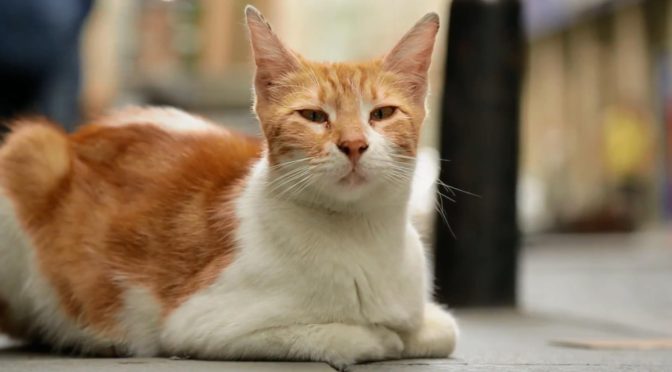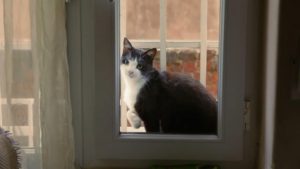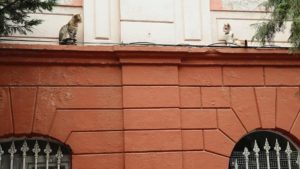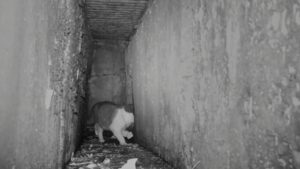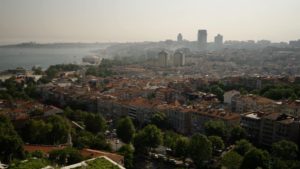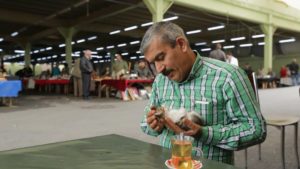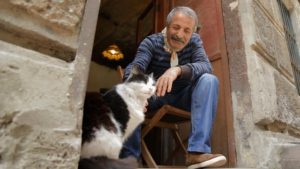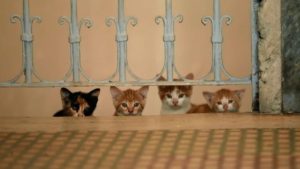2017 gave me many an opportunity to feel thankful. A new job in the lovely, little city I call home. Countless moments in the company of friends and family. The opportunity to spend time with an amazing nephew just as he’s finding his inimitable two year-old swagger. I saw Chicago for the first time and I made the decision to ask my spouse to marry me. And with all of that said, let me not mince words: I could never bring myself to call 2017 a good year. The past 12 months have been frequently beset with gloom, from the mass shooting in Las Vegas to the deluge that swept through Houston. From the conflagrations that razed my home state of California to the profane Hydra of avarice, apathy and bigotry that besieged Washington D.C. And for all the many reasons I love Film, chief among them is its ability to raise its voice in times of conflict. At its best, Film speaks to us of our environment and calls out injustice. And 2017, more than any other year in recent memory, really was a time for Film to smear black makeup under its eyes and help lead the good fight. I am pleased to say there were a number of films that did just that. Some such films appear higher on my year-end list. Others (The Shape of Water, Wonder Woman, Coco) did not make my list, but nonetheless hold my undying admiration for the fine, noble, humane ideas they represent. But as much as this is a time for fortitude and human solidarity, I must confess that the first film on my list is not any great statement about the kind of year 2017 was. It has no real fire to breathe and is not even primarily concerned with humanity at all. What Kedi, one of the three best documentaries of 2017, does provide is a kind of salve for the burns and abrasions of a tough year. As I type this, even a word as modestly comforting as “salve” feels almost hyperbolic for a movie this disarmingly sweet, but it feels right. Precious few of this year’s films soothed and reassured me the way this one did. At the end of the day, maybe I just came to realize what the greater Internet has known for decades now: as a home remedy for anxiety and dread, there are few cures more effective than watching videos of cats.
I do have my tongue a little bit in cheek in calling Kedi a cat video, but it gives me joy to think of it that way. If watching moving images of felines in all their majesty, eccentricity and hilarious inscrutability has long been one of the most reliable sources of joy and relaxation for an entire planet of web surfers, then it only stands to reason that there should be a filet mignon of the genre. What I love about Kedi is that I can call it the high watermark of cat behavior films, mean it sincerely, and have that be the least of the various compliments it deserves. It is also an ingenious little hybrid of a nature documentary, in which the natural environment happens to be a city. Kedi is not merely a cat movie but a movie about feral cats specifically, and it is even more specifically about the teeming multitude of feral cats that make their home in the Turkish capital of Istanbul. It is a film about the many cats who call this ancient city home and it is about what these peculiar, enigmatic animals mean to that city. One of the most effective conceits of Kedi is how the filmmakers set out to know the cats better by knowing the city better, and vice versa. The documentarians follow the cats through this urban landscape and a good part of the wonder comes from how well they assume a cat’s perspective. It is one thing to distantly film lions across a wide open savannah and quite another to literally shadow the wild version of a house cat through the bustling streets and narrow alleyways of a dense cityscape. The filmmakers embrace the challenge, not only following their feline subjects into little shops and down side-streets, but using smaller cameras to go with them into the smaller nooks that naturally make up an undomesticated cat’s environment. The cameras follow the cats down into the small crevices beneath sidewalks to chase rats and up on to high ledges of old buildings. While I have thus far described Kedi as a sweet and modest film, I have to applaud it for being quite a dexterous, energetic piece of filmmaking. In its humble way, it is the kind of documentary I always want more of: curious, observant, and filled with just as much cinematic verve as it needs. The film also gains considerable charm from not simply being about cats in general, but by looking closely at specific cats. One Istanbul resident marvels that every cat has its own unique personality and Kedi latches onto that idea by giving each cat its own self-contained chapter. One is a mother embracing a newfound sense of courage and responsibility. One is a charismatic ne’er-do-well with a penchant for breaking and entering and getting into fights he is incapable of winning. Another is an enterprising hunter who offers his rodent-killing services to a nice restaurant in exchange for a daily supply of fine fish entrails. One cat is a troublemaker who throws his weight around the local marketplace, and the film salutes his rebellious moxie by giving him his own Turkish rock soundtrack. I do not think I am incorrect in calling Kedi a modest film, but there is also such an engaging sense of detail to these animals and their hometown. I could concede that it is a film with humble aspirations, but it is also too attentive, sincere, and genuinely engaged to ever be slight.
What makes Kedi so much more than the sum of its feline parts really comes down to a delicate balance of tone. When I first saw the film, I gushed that I had just seen a Linklater film about cats, which is basically the nicest thing that could come out of my mouth, if you know what a lyrical, animal-loving, sentimentalist I am. In the end, what I really mean is that Kedi is warm, gentle, subtly spiritual, and it left me feeling very good about being alive. What really put me in mind of Richard Linklater is probably how lovingly it honors a great city without that ever being its raison d’etre. And here is where Kedi adds another notch to its belt: it stands among the finest travelogues I have ever seen without explicitly setting out to be a travelogue. Much as Linklater’s divine Before Sunrise blissfully captured the heart of Vienna by just watching its romantic leads stroll through it, Kedi paints a vivid portrait of modern Istanbul just by following the cats through a beautiful, old city and staying keenly attuned to how they interact with it. The film’s first title card notes that Istanbul’s cats have been a part of its character and its very architecture for thousands of years, and one of Kedi’s chief arguments is how the lifeforms that occupy a space help to define its personality. Istanbul is not just a city full of cats, in the way that New York City is a city full of rats. Istanbul is a place that draws an ineffable essence from its most famous animal, and there is great beauty in how it continues to shelter and nurture them. And while I would defend Kedi to the end of my days if it were just the best “cat video” ever made, I can now say that it is much more than that. It is about the soul of Istanbul and how it has become inextricably linked with the spirit of the wild cats that have spent generations upon generations living and thriving there. In that way, it seems to posit that what makes a city beautiful transcends mere architecture. The beauty of a place must be understood through the lifeforms that call it home. The film’s first image is a panorama of the rooves of Istanbul. I came to appreciate how the film starts from this removed, aerial position and then zooms down into the tiny cracks that truly make up the city. In that way, Kedi says to me that, for as much as one can grasp the beauty of a city from a postcard or the view from an airplane, the true joy of any place exists at the ground level. In the end, Kedi’s twin successes as both a cat documentary and a travelogue of Istanbul do not exist in isolation. They support each other in the same way that the cats and the city have for so long. Following the cats allows us to see Istanbul intimately, and getting to know Istanbul in its finest details allows us to better understand the cats. Kedi is something I had never seen before: a heartfelt tour of a gorgeous city, conducted by that city’s power animal.
But what I love the most about Kedi, and what takes it beyond being one of the more novel, well-crafted nature documentaries ever made is how it follows Werner Herzog’s insight in Grizzly Man that films about wild nature are really films about human nature. In seeing these street cats as the key to unlocking Istanbul, the filmmakers also imply that these animals can help us understand the generous soul of the city’s people. The filmmakers have palpable love for the way Istanbul’s residents not only tolerate these street cats but treasure them. Kedi shows how a spirit of kindness and curiosity toward another lifeform is really a manifestation of self-curiosity and self-love. On some level, it is about the human tendency to project ourselves on to animals and how that can help put us in touch with our better angels. Animals can be a reflection of our best selves and our aspirations of who we wish we could be. One young woman looks at a cat she feels close to and admires her eloquence and proud femininity. She sees this animal and suddenly she wishes that more women in Turkish society felt as empowered to be defiant with their womanhood. A chef at a fancy delicatessen regards the cat who regularly patronizes his restaurant as an animal of both regal bearing and polite humility. He likes that this animal is determined to find a meal, yet never outwardly begs for his food. He refers to him as a cat with manners; an animal with the refined self-possession of an aristocrat and the moxie of a street kid. As I watched this proud man talk, I wondered how much his impression of this particular cat tapped into a sense of self. I could now imagine a man of meager beginnings who had molded himself into a person of sophistication and substance. And beyond mere projection, Kedi is also about that most precious quality in human beings: empathy. The ability to look at something that is not yourself and care for it. Kedi introduces us to two men who have experienced some hardship and found a renewed feeling of hope and compassion in these street cats. One suffered a financial setback when his boat sank and the other experienced a nervous breakdown. Both have found something restorative in helping the cats, checking in on them and bringing them food and medicine. They seem to have found solace and strength in the simple act of being good to another life in need. “They make you fall in love again”, one man muses contentedly.
Kedi is also about the value of basic gratitude for the world around us, be it a cat, a beautiful old city, or a fellow human being. That sense of humble joy really resonated for me on a second viewing. Kedi is filled with a sense of wonder and thankfulness for the simple joys of life and, without making any great fuss about it, I think the film is about how that sense of appreciation can be a bedrock for your soul in times when life feels harsh and austere. One man reflects that if you can find joy in looking at a cat, then the world will be yours. That is a feeling I have long held. That life’s greatest gift is just consciousness itself and our ability to sense and experience the tiniest pleasures of the world around us. And now I want to be very careful not to come off like some sedated self-help guru cliché; to not venture out of my depth and into a quagmire of cheap bromides and pat slogans. There are weighty matters in this wide world of ours, and a great many of them cannot be satisfied by gratitude and appreciative acceptance. I am fairly sure there are quite a lot of injustices that will only start to get better when humanity becomes less grateful and accepting. A sweet, humane film about cats will not fight off any of the threats that loom over our world, nor will it marshal any significant ideological sea change. There are real battles to be fought and serious discourses to be had and, as I said before, I look to Film to get its hands dirty in all of that. But battles do not just need weapons, armor, and ammunition. Wars also require poultices, bandages, and salves. Small trifles still have value in times of strife. We will still have need of gangly comedies, featherweight romances, and glitzy musical extravaganzas. And I am happy to say I am not so far gone that I do not feel a profound sense of adoration for this generous, lyrical cat video. Kedi is a small, good thing and the ability to appreciate small, good things is a way of checking our pulses to make sure we are still human. If Kedi is not a great mirror for our times, it is nevertheless some more humble form of mirror, capable of reflecting ideas that are warm-hearted, wholesome, and no less valuable for being small.
